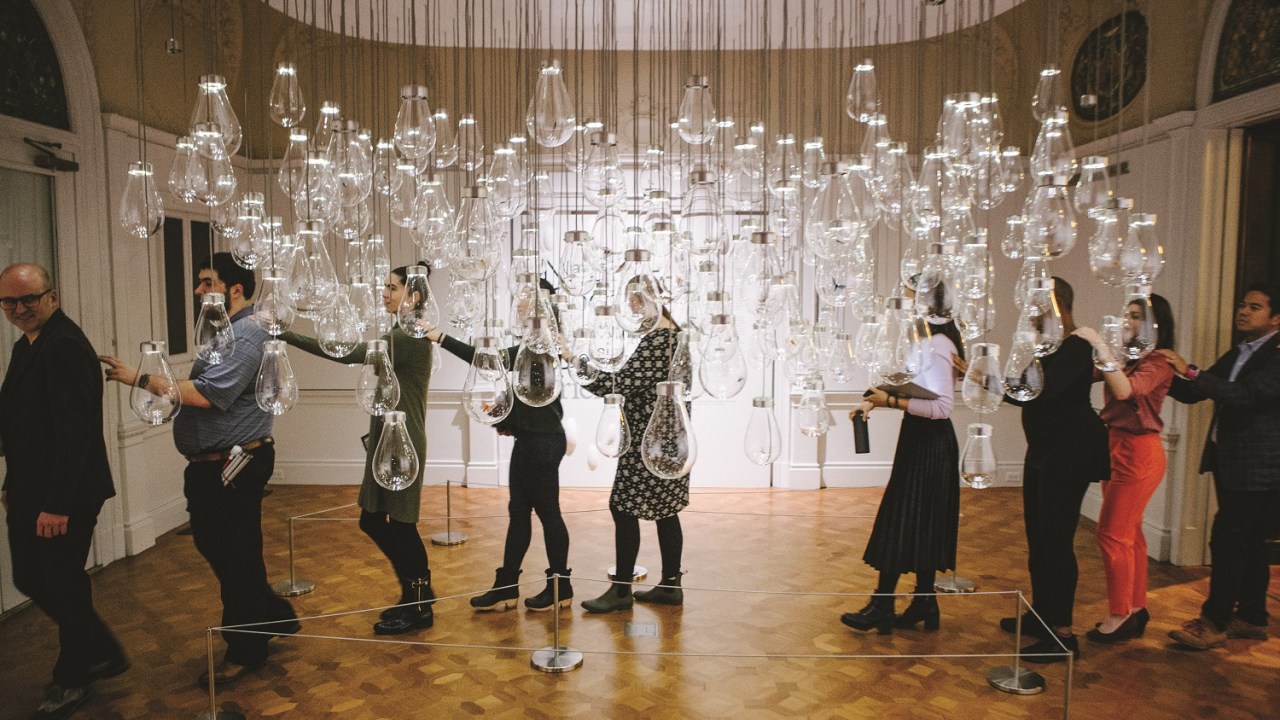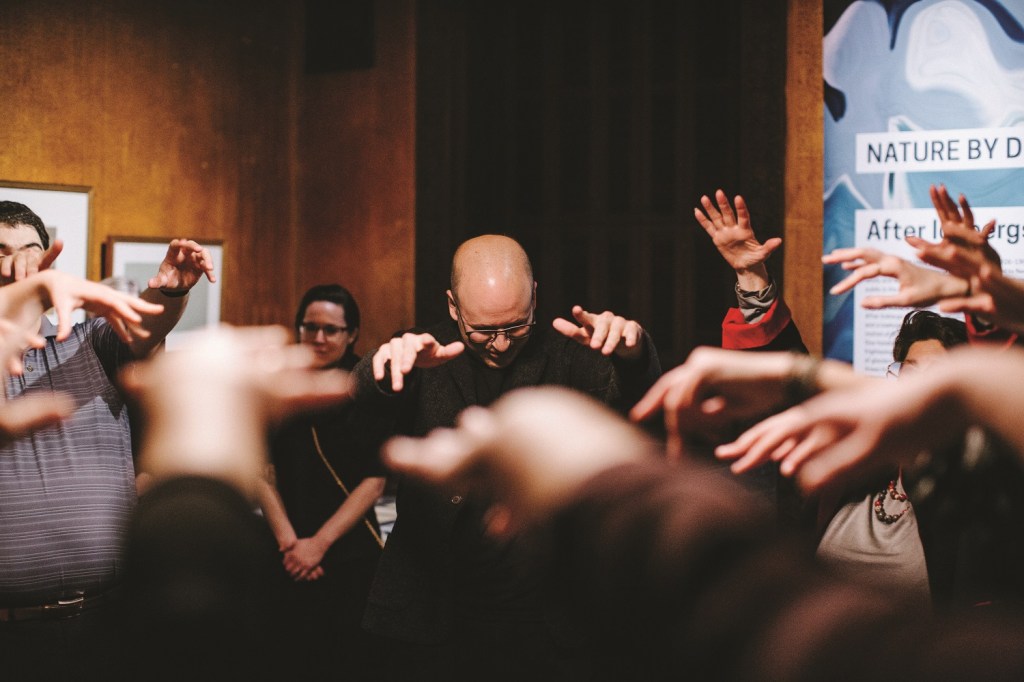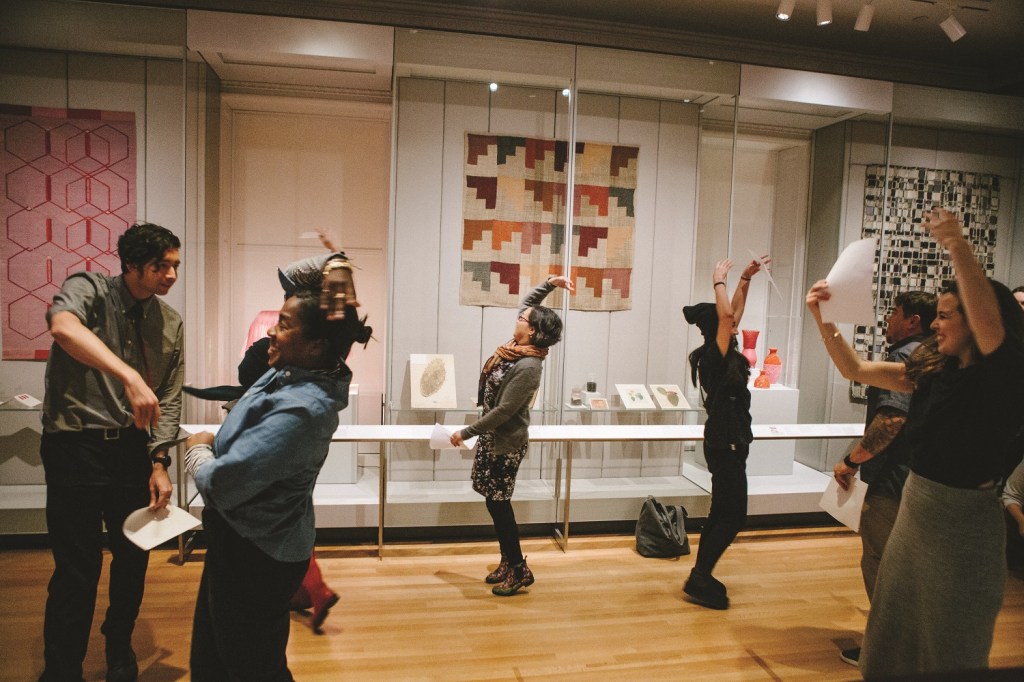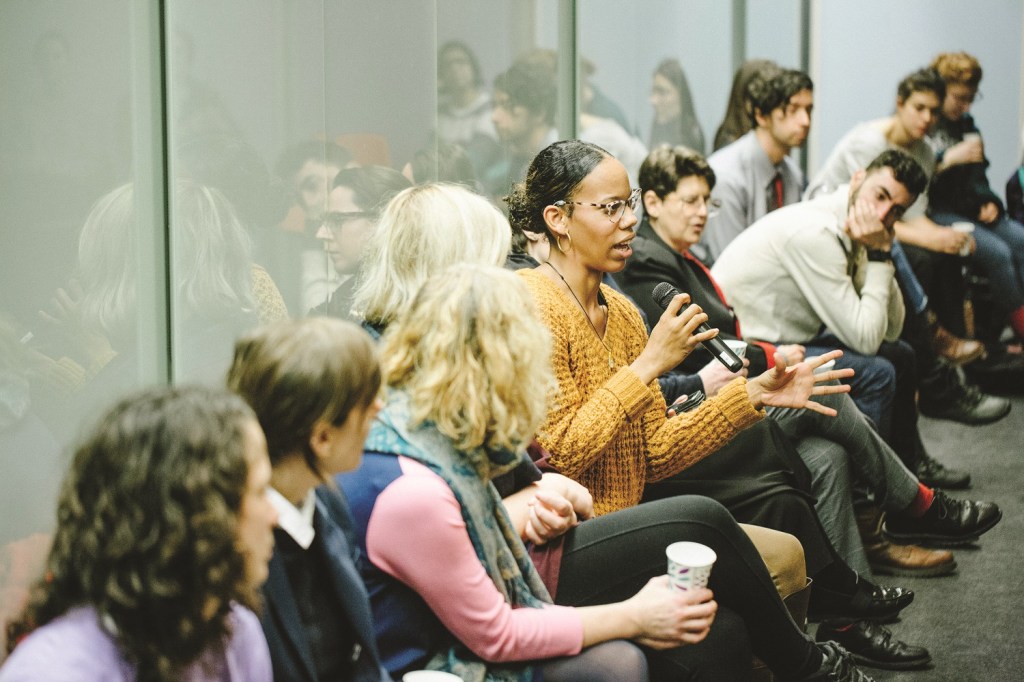
This article originally appeared in the November/December 2020 issue of Museum magazine, a benefit of AAM membership.
The Interaction Lab at Cooper Hewitt, Smithsonian Design Museum seeks to re-envision visitor experience.
The idea behind the Interaction Lab (the Lab) at Cooper Hewitt, Smithsonian Design Museum is simple: museums can build audiences by proposing new ways of interacting with them. The Lab is a new kind of research and development program designed to challenge assumptions and expand thinking about visitor experience and introduce new ways for audiences to engage with the museum across physical, digital, and human interactions.
If you’ve already heard of the Interaction Lab, it’s most likely because of our public programming, launched in September 2019 with a discussion about museums and artificial intelligence (AI) in collaboration with UK-US research group Museums + AI Network. Over the following six months, we held four more sold-out public programs, for audiences of 100 people, that introduced provocations and ideas based on needs uncovered in our cross-departmental work at Cooper Hewitt and observations from the museum sector. Topics included the relationship between interpretation, design practice, and storytelling; using bodystorming to explore accessibility; connecting information design to sensemaking; and a prototyping session on storytelling and systems architecture with the Columbia University School of the Arts’ Digital Storytelling Lab.
Each program began with invited designers and practitioners framing the discussion, followed by workshops in which participants could apply those ideas for themselves. For example, in “Interpretation as Storytelling,” three experts spoke about aspects of their design practices—graphic design, interactive narrative design, and extended reality design—and their potential implication for museum practice. Then the designers led experiential workshops in the museum demonstrating how that technique might apply to reimagining museum labels, using Disney tactics for exhibition design, and creative concepting with augmented and virtual reality in-gallery. At the end, we reconvened to discuss our findings.
Creating this kind of playful, participatory space has proven hugely popular, especially for provoking meaningful connections among strangers. Based on the response from museum sector professionals and the public, it’s clear that a lab focused on visitor-facing interactions resonates across industries and interests. Feedback from post-program surveys has been consistently positive, with comments like “as a regular museum visitor, it was amazing to have the opportunity to discuss storytelling with the head of interpretation from a [major NYC museum].”
Though our public program series is the most visible manifestation of the Lab’s work, there’s much going on behind the scenes. In fact, the vast majority of our efforts are driven by insights surfaced through internal strategy and creative development.
Designing for Our Internal Audiences
In the Lab’s first year, we brought together various cross-departmental stakeholders from Cooper Hewitt in six workshops to reflect on what we’ve learned since the museum’s post-renovation reopening in 2014 and do some big thinking about the future. When necessary, we engaged workshop leaders, such as the museum-focused research firm Frankly, Green + Webb, for its keen insight on experiential strategy. In other sessions, we collaborated with groups of designers, storytellers, technologists, and outside partners like Facebook’s AI and New Experiences Team to think about engagement strategies from other sectors that might be applicable.
In these workshops, we generated ideas about futures for collecting (the central interaction of our current museum experience), adding digital intelligence to our historic mansion, onboarding first-time visitors, and embedding storytelling capabilities in everything from how we store, manage, and serve collections data and digital content to the design of in-gallery experiences. Based on workshop outcomes, we have worked with other staff to prioritize where to focus our prototyping activities with external designers and partners. Then we’ll develop and scale individual ideas into a reimagined experience.
In addition to offering internal facilitation and sensemaking, the Lab is beginning to provide strategic design support for upcoming exhibitions and programs by researching and prototyping new approaches to design and interactivity based on visitor needs, internal objectives, and experiential goals.

Creative Commissioning as R&D
One of the primary ways we prototype ideas is by inviting designers and practitioners to work with us via the Interaction Lab Creative Commissioning Program. When we identify a design opportunity, we request proposals from independent designers, design studios, and creative technologists that outline solutions they want to explore with us. Then we award funding to prototype proofs of concept of the best submissions. Investing small amounts of money in exploring multiple early stage ideas maximizes the impact we can generate with a modest budget.
Our commissions are varied. While entry is timed and capacity reduced, we’re working with design studios specializing in games and industrial design to explore the effectiveness of different kinds of storytelling approaches and interactive mechanics in guiding visitors through the physical museum. We’re also actively exploring new applications for current interactive experiences, which include digital tables and our projection-based Immersion Room. And through next spring, we are working with a partner on new creative software applications for Open Access collections. This latter program commissions concepts from an open call for proposals to ensure that we create space for new practitioners with fresh ideas.
In addition to addressing specific needs, the design commissions help expand and challenge our thinking about museum experience and present opportunities to share our learnings through publications and public programs. To ensure we maximize the benefits of this approach, we’re not only evaluating the prototypes themselves, but also tracking the impact of commissioning on the institution to help us refine our approach going forward.

Co-creating with Partners
In creating a “lab without walls,” we conceived of a porous border between the museum and external partners, which include individual designers, design firms, tech companies, and community organizations, to name a few. Whether the partnership is focused on research, building tools or platforms, designing products and services, or something entirely different, we want to bring fresh eyes, voices, and ideas into the conversation and build relationships around common questions to serve shared or related audiences.
Presently, we’re working with a tech company to prototype a storytelling-driven database that will link collections data to digital content from our website and other channels, allowing us to share richer, deeper, more connected stories with audiences of all kinds, both in-gallery and online. We’re also collaborating with our CRM (customer relationship management) partner to rethink the entrance experience, including everything from the first web visit to the moment visitors enter the galleries: What’s essential? What isn’t? How might a redesigned ticketing interface better support the right kind of entry experience for Cooper Hewitt?
In addition, we plan to develop partnerships that explore strategies for deepening engagement with our exhibitions and collections and designing new pathways and experiences for visitors to interact with our historic mansion, both on- and offline.
What Now?
Before COVID-19 reached our shores, we planned to continue in-person public programming and begin commissioning prototypes through the spring and summer, and we expected to start sharing outcomes in the fall of 2020. Then everything changed. Like everyone else, we re-examined, adapted, and continue to adapt.
That the pandemic triggered a series of crises for museums is a clear indication that things already needed to change. After all, if museums aren’t able to be physical spaces full of objects, supported by dynamic in-person programming, then what are they exactly, and for whom, and what might they be in the future?
We believe opportunity lies in envisioning medium- and long-term futures different from those we imagined before COVID-19 that go beyond simply responding to new constraints. The Interaction Lab’s public contribution to this discourse thus far has been two online programs framed by Arundhati Roy’s brilliantly articulated metaphor from her Financial Times article “Pandemic as Portal.” Using this portal metaphor, we sent small groups of participants into Zoom breakout rooms to discuss prompts related to museum futures and used online whiteboarding software, Miro, to document together.
The first program, “Pandemic as Portal: Exploring the in-between,” took place in early May, and welcomed almost 180 participants from 21 countries to share what they are currently seeing, feeling, and hoping to leave behind and what they want to bring with them into the future. In August, we ran our second program, “Pandemic as Portal: Preparing to emerge,” which focused on the museum experience in this time before we emerge from our socially distant bubbles.
As for visitor experience strategy and commissioning, the pandemic has inspired bigger thinking about what’s possible at Cooper Hewitt. During our closure, the Lab has supported and facilitated internal programming conversations and has proposed a research program to explore new ways to use our galleries and physical spaces. Moving forward, we will be initiating design commissions to explore content and experiences related to the new conditions we are experiencing (see “Moving Through a Museum in a Pandemic” sidebar on p. 50).
To expand the conversation beyond our walls, the Lab is convening a group of museum professionals across education, interpretation, curatorial, design, and visitor services, thanks to the generous support of the Samuel H. Kress Foundation. Through a combination of small group workshops and online public programs, the series will explore tactics for designing exciting museum experiences in person and at a distance. Rather than designing the workshops ourselves and inviting people to attend, we’re testing an approach that invites participants into the process as collaborators, sharing among all who participate facilitation and documentation responsibilities, financial compensation, and authorship of the resulting toolkit.
The pandemic is a portal, certainly, but it’s not yet clear how much of what’s on the other side resembles the past. But we can learn from what has already happened over the months between closing and reopening. We can make the decision to approach this period as a series of opportunities and experiments, making space to prototype our way forward, learning and adapting as we go, and responding to new audience needs as they emerge.

Moving Through a Museum in a Pandemic
In early Interaction Lab brainstorming, we heard frequent requests for a “choose your own adventure” museum experience. Diving deeper, we quickly understood that “adventure” really meant a designed experience that follows an arc across beginning, middle, and end. So we commissioned designers to explore how storytelling could guide visitors through the museum.
Then COVID-19 hit. Safety-driven design constraints for visitors and staff now supplemented our existing questions about moving people through the museum. Though we still don’t have all the answers, here are the questions we are exploring in our research.
How might timed ticketing and reduced capacity support testing new visitor interactions?
A fixed number of visitors arriving at predetermined times presents an amazing opportunity to prototype things like self-guided story-driven experiences, redeploying visitor experience associates as visitor engagement leaders, and reimagining our entrance experience to focus more on engagement and less on transaction.
How might new experiences be designed to bridge online and in-gallery environments?
As we build new online tools that create deeper engagement with our collections, we’re also considering how to evolve our existing in-gallery digital experiences, like our multitouch digital tables and projection-based Immersion Room, to respond to new COVID-19 “touch” conditions and build in more value for visitors.
What might we learn from other arts and design disciplines?
Perhaps the greatest value of the Interaction Lab is our ability to collaborate with creative professionals in new ways. We are engaging choreographers, directors, and immersive performers to help us think differently about our spaces; working with information designers to expand interpretive approaches; and tapping digital humanities and the immersive storytelling community to prototype new tools for storytelling that might be applied to our collections and exhibitions.
Resources
“Recapping the View from Inside—Pandemic as Portal: Exploring the In-between” by Angela Perrone, Katherine Miller, and Rachel Ginsberg bit.ly/2Gsmh8F
“Designing for Now: The Implications of ‘Going Online’” by Rachel Ginsberg bit.ly/3jJUD5e
Rachel Ginsberg is director of the Interaction Lab and Carolyn Royston is chief experience officer at Cooper Hewitt, Smithsonian Design Museum in New York City.







